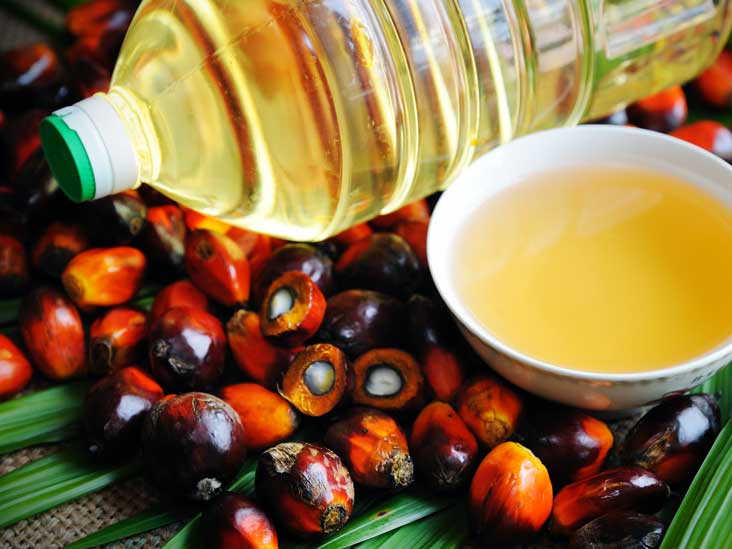Palm oil is a common ingredient found in a variety of products, including household goods, food products, and personal care items. It is even found in baby formula as it helps to stabilize milk powder.
It is estimated that palm oil is present in around 50% of all products sold in the West and is becoming increasingly prevalent globally, with a record-high consumption of 73,866,000 metric tons in 2021. However, there are several concerns surrounding the use of palm oil.
One major concern is the risk of cancer. The refining process of palm oil produces carcinogens. Hazardous carcinogenic contaminants are released when palm oil is heated to temperatures above 392 degrees Fahrenheit (200 degrees Celsius). Furthermore, the repeated heating of palm oil during cooking can lead to the production of free radicals, which are associated with an increased risk of cancer. In addition, saturated fat in palm oil is mostly in the form of dietary palmitic acid (PA), which has been linked to cancer metastasis, or the spread of cancer cells. However, fatty acids in other oils, such as olive oil and flaxseed, did not display this danger.
Another primary concern is the risk of cardiovascular disease. Palm oil is high in saturated fat, with 40% to 50% of its total fat content being saturated. This can increase saturated fat and cholesterol intake when consumed regularly, which has been linked to an increased risk of weight gain, obesity, and insulin resistance. One tablespoon of palm oil contains 7 grams of saturated fat, which is almost half the daily recommended limit for a 2,000-calorie diet. Consuming palm oil in addition to other saturated fat sources, such as dairy, meat, and processed foods, can increase the risk of exceeding the recommended limit. Saturated fats have been linked to an increased risk of cardiovascular disease. Consuming saturated fat from palm oil can raise levels of bad cholesterol (LDL) in the body. Over time, this can cause a stroke or heart attack. Additionally, the frequent heating of palm oil for cooking purposes can contribute to the development of atherosclerosis, which is a leading cause of cardiovascular disease.
One study analyzed data from developing countries between 1980 and 1997 and found that higher levels of palm oil consumption were associated with higher rates of mortality due to ischemic heart disease (coronary heart disease) in people over the age of 50. The study found that for every additional kilogram of palm oil consumed per person in developing countries, there was a 68 per 100,000 increase in ischemic heart disease mortality.
Palm oil can also potentially increase the risk of hypertension (high blood pressure). In addition to its cholesterol-raising properties, palm oil can also release free radicals when heated, which can cause irritation to blood vessels and lead to arterial thickening, a potential cause of high blood pressure.
Moreover, refined palm oil, which is the most common type found on the market, has been stripped of many of its vitamins and nutrients. This leaves behind mostly fat and other substances that the body has difficulty digesting, providing few health benefits in return.
Recently, Bill Gates invested in C16 Biosciences, a startup that produces synthetic palm oil in a lab as a more sustainable and environmentally-friendly alternative to traditional palm oil grown in rainforests.
The International Finance Corporation (IFC), a member of the World Bank Group (WBG), has also released a framework for its involvement in the palm oil industry. The World Bank Group has a long history of investing in palm oil production, particularly in developing countries such as Indonesia, Thailand, and Malaysia. In fact, the World Bank has invested over $2 billion into the palm oil industry since 1965, with at least half of those funds going to Indonesia and Malaysia. Many palm oil companies, such as Wilmar International, have received loans and development funding from the World Bank and IFC. In the past 45 years, since the World Bank began significantly funding palm oil production, oil palm plantations have expanded 8-fold globally, with a 23-fold increase in Indonesia alone. The World Bank has financed 15 palm oil projects in Indonesia and has touted the “successful establishment of 100,000 hectares of oil palm plantations.”
As you can see, around 45 years ago, which is when wealthy groups took an interest in palm oil, is when palm oil production sharply skyrocketed. Now, palm oil is produced more than any other oil.
Ultimately, it is crucial to consider the potential health risks associated with the use of palm oil. It may be advisable to limit the consumption of products containing palm oil and to look for alternatives when possible.
